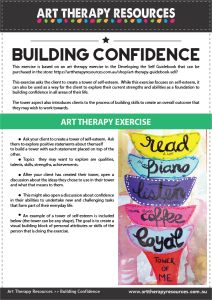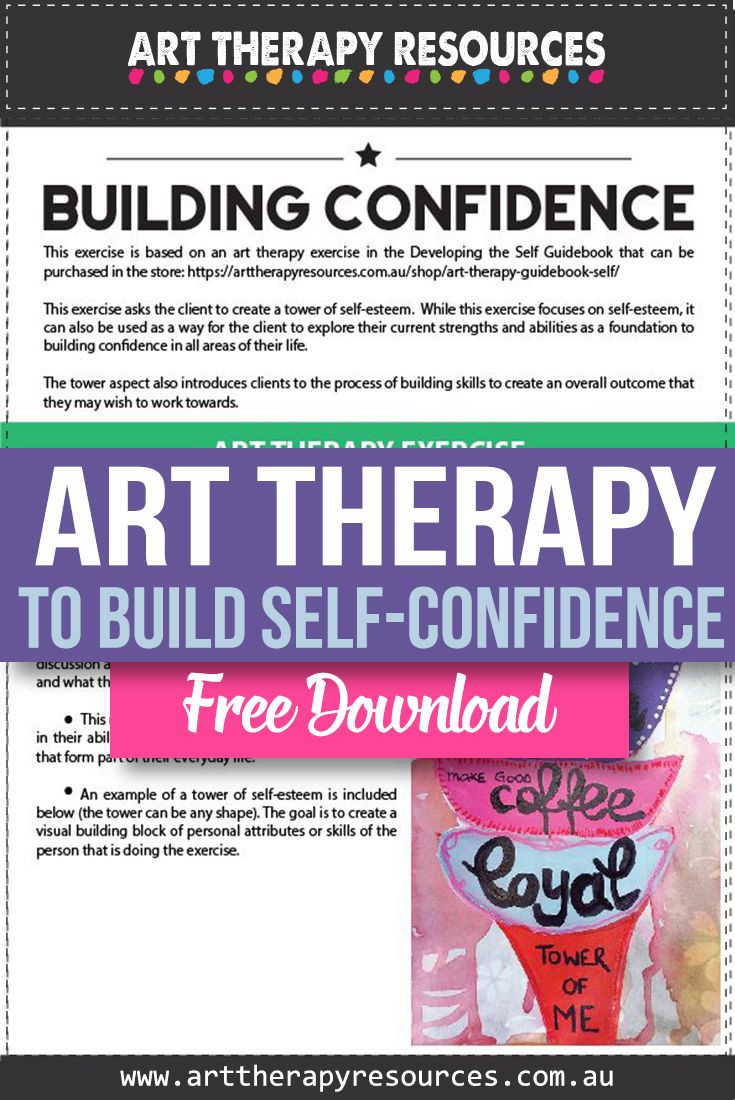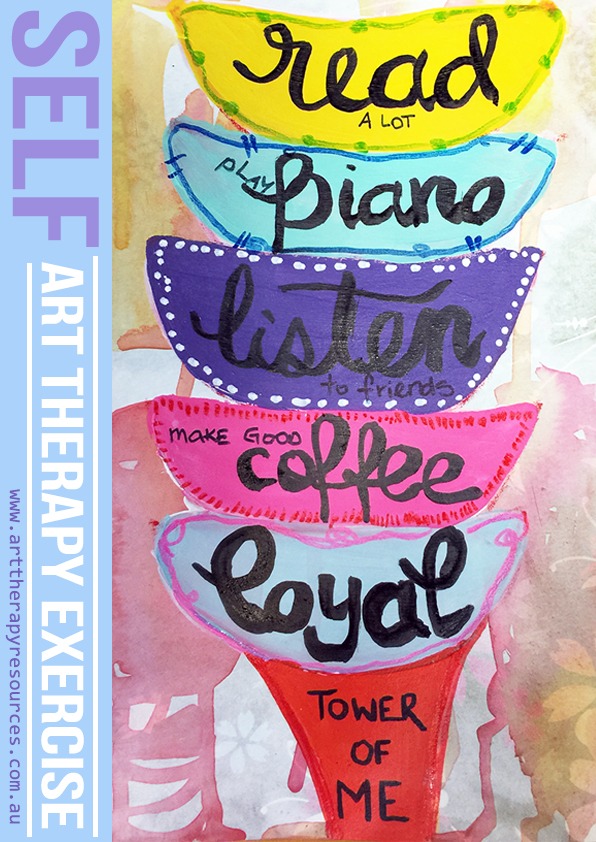THIS POST INCLUDES:
1. What is self-confidence
2. How to build confidence
3. Art Therapy and self-confidence
4. Free Download Art Therapy Exercise
WHAT IS SELF-CONFIDENCE
Confidence is defined as the belief you have in your ability to succeed or handle a challenge that you may be presented with at a point in time. Self-confidence is often confused with self-esteem. In summary, self-confidence is often transitory and short-lived, whereas self-esteem is a more long-term view we hold of our self-worth.
Though they both appear related in some way to the self, a person can have self-confidence, yet have little self-esteem. This is particularly evident in the case of performers who have the self-confidence to stand up and perform, yet suffer from low levels of overall self-esteem.
The short-term nature of self-confidence means there can be periods of self-doubt in between each experience of self-confidence.
Confidence can be situational and connected to familiarity. Someone operating in a job for 20 years can have a high level of self-confidence in their ability to do their job. However, this self-confidence may not translate to other areas in their life.
For this reason alone, it can often be easier to build self-confidence in a situation or a skillset based on repetition and familiarity, whereas, self-esteem can sometimes involve complex introspection to resolve.
Self-efficacy is another common term used to describe a person’s self-belief. Self-efficacy is a term more commonly used in the psychological approach, whereas self-confidence is more commonly used amongst the general public. A small distinction can be made in that self-confidence is the ability to carry out the task, skill, or cope with the situation, whereas self-efficacy is a more overarching belief an individual holds about their capabilities to impact their outcomes at all.
In this sense, a person may have a high level of self-efficacy that they can be confident enough to undertake a skill or cope with a situation.
Overall self-confidence generates positive benefits for the individual, including:
- High level of participation in positive life activities
- Decrease in self-doubt
- Higher levels of motivation for change
- Increased participation in new and challenging experiences
- Increased levels of social interaction
Negative outcomes can also exist with increased levels of self-confidence such as higher expectations and a sense of entitlement on outcomes. However, overall, these aspects usually involve other complex individual factors that should be considered other than simply high levels of confidence.
HOW TO BUILD SELF-CONFIDENCE
Self-confidence is at our highest when we are in situations that are familiar and undertaking activities we normally do. Familiarity, repetition, and highly developed skills give us the feeling of assurance that we can cope with the situation we are in.
In situations where we may not have that assurance of familiarity, we can decide to either avoid uncertainty, or we can decide to employ courage to give us the motivation to persevere.
Courage is not a magical trait that only the brave and fearless possess. Instead, courage can be fostered by holding the belief that no matter the outcomes, the effort we put in is important to us. Courage allows us to take bold steps but also acknowledges that not everything works out as we may expect. We can also appreciate that we can use what occurred in moments of courage, and apply it to future experiences.
In many ways, building self-confidence entails a significant effort to change perception. If we know we possess all the ‘ingredients’ to undertake a task or cope with a situation, then our perception can be altered to reflect a stronger belief in our ability to cope with that situation. For example, if we are going for a job interview. We may have already addressed the requirements of the job in terms of skills and experience, however, the interview may be dependent on our self-confidence in performing in the interview under pressure.
A similar example may be attending a social event. We may already have some basic skills in introducing ourselves and conducting a conversation, however, any doubts we have about attending may simply be eliminated by changing our perception about our ability to hold those conversations with others.
Some things we can do to boost our confidence include:
- Undertake good health behaviours such as sleep, exercise, and eating. Feeling healthy can give us the confidence that we have the physical stamina and energy to undertake difficult tasks.
- Use visualization techniques to see yourself completing the task or coming through a difficult experience.
- Embrace imperfection, risk-taking, mistake-making, and unexpected outcomes. This will shift the focus from unknown outcomes to concentrated efforts.
- Set goals where you can define, measure, and adjust your behaviour and perception to successfully do what you want to do.
- Engage in self-care to help maintain your energy levels as you try new things.
- Undertake fun hobbies or activities where you can participate in skill-building without any necessary expectation or goal setting. Eg reading, walking, art, cooking, games, sports etc
- Seek support while you build self-confidence so that others can provide you extra words of encouragement along the way.
It’s important to understand that process, progress, and practice are all necessary parts of building self-confidence as you work on areas of self-improvement.
ART THERAPY AND SELF-CONFIDENCE
Art therapy provides the below positive benefits for those looking to build self-confidence:
- Self-expression – repressed thoughts and emotions can be expressed through art without any verbal censorship or limitations.
- Sense of autonomy – the artwork becomes a place in which an individual can make choices about art materials and how to use them in their project.
- Increased self-worth – creating art can provide a container for individual self-expression that connects with an individual’s desire to be heard, seen, and understood.
- Increased self-esteem – creating art provides a safe space in which individuals can increase their self-esteem through expression, autonomy, and increased self-worth.
Art therapy involves three important components that help facilitate personal growth and development which can lead to building self-confidence:
- participating in the creative process
- the positive outcomes from the art making activity
- the therapeutic process of creating
Art therapy can enhance an individual’s self-confidence by:
- Facilitating creativity – this can be a confidence building process by encouraging skill building through the use of art materials and creative ways to express cognitive and emotional connections
- Increased self-esteem – can boost mastery skills and the client’s belief in their ability to create and express themselves
- Individual support – facilitated by the art therapist and their relationship with their client
- Group support – clients can be part of a group that has similar experiences and use art making as a source of creating social bonds
- Non-judgmental expression – the client can express without judgment in their artwork
One of the key aspects of confidence is acknowledging and building upon the strengths that the client has. By acknowledging these strengths, individuals learn they are capable and use this as proof to boost confidence in themselves.
Art therapists may find clients who downplay their creative skills and believe that art therapy requires a developed skill level at drawing or painting. The art therapist should convey that art therapy is not focused on the creative outcomes of making art, but instead, more focused on the process of art making.
Art therapists can introduce art making to clients using non-judgment and openness to help individuals feel confident in participating in art making. From this point of view, it’s helpful for art therapists to remind clients that art making can be playful and available to embrace imperfection. Furthermore, art therapists can also help clients understand a broader definition of the word art and what it means to each of us personally.
This way art therapists can show clients that engaging in art making can help develop competence around art materials and how they can be used as part of their unique self-expression.
Any self-doubt that the client exhibits in making art can often serve as an opening to exploring the client’s held beliefs about their abilities and the concept of trying new things without expectations.
ART THERAPY EXERCISE
This exercise is based on an art therapy exercise in the Developing the Self Guidebook that can be purchased in the store.
This exercise asks the client to create a tower of self-esteem. While this exercise focuses on self-esteem, it can also be used as a way for the client to explore their current strengths and abilities as a foundation to building confidence in all areas of their life. The tower aspect also introduces clients to the process of building skills to create an overall outcome that they may wish to work towards.
ART THERAPY EXERCISE INSTRUCTIONS:
- Ask your client to create a tower of self-esteem. Ask them to explore positive statements about themself to build a tower of self-esteem with each statement placed on top of the other. Topics they may want to explore are qualities, talents, skills, strengths, achievements.
- The goal is to create a visual building block of the personal attributes or skills of the person that is doing the exercise.
- After your client has created their tower, open a discussion about the ideas they chose to use in their tower and what that means to them.
- This might also open a discussion about confidence in their abilities to undertake new and challenging tasks that form part of their everyday life.
An example of a tower of self-esteem is included below (the tower can be any shape).
FREE DOWNLOAD: Art Therapy Exercise
SIGN UP below to download the FREE Art Therapy Exercise. Once you sign up to our mailing list, you will gain immediate access to our FREE resources library.

BUILD YOUR ART THERAPY REFERENCE MATERIALS:
Pin this image to your Pinterest board.

SHARE KNOWLEDGE & PASS IT ON:
If you’ve enjoyed this post, please share it on Facebook, Twitter, Pinterest. Thank you!

